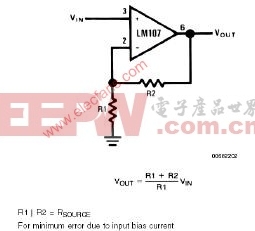同相放大器-The Non-Inverting Amplif
同相放大器-The Non-Inverting Amplifier
Figure 2 shows a high input impedance non-inverting circuit. This circuit gives a closed-loop gain equal to the ratio of the sum of R1 and R2 to R1 and a closed-loop 3 dB bandwidth equal to the amplifier unity-gain frequency divided by the closed-loop gain. The primary differences between this connection and the inverting circuit are that the output is not inverted and that the input impedance is very high and is equal to the differential input impedance multiplied by loop gain. (Open loop gain/Closed loop gain.) In DC coupled applications, input impedance is not as important as input current and its voltage drop across the source resistance. Applications cautions are the same for this amplifier as for the inverting amplifier with one exception. The amplifier output will go into saturation if the input is allowed to float. This may be important if the amplifier must be switched from source to source. The compensation trade off discussed for he inverting amplifier is also valid for this connection.

图2给出了一个高输入阻抗,同相放大器电路的电路。其闭环放大倍数为(R1+R2)/R1,其闭环3dB带宽为其单位增益带宽除以其闭环增益。和反相电路相比,其最大的不同点在于,其输出信号和输入信号是同相的,其输入阻抗也是相当高的,为OP差模输入阻抗与环路增益的乘积(环路增益为:开环增益/闭环增益)。在直流耦合情况下,输入阻抗对于OP电路的影响作用比起输入电流,主要是由于其在信号源内阻上所带来的压降来说,是在次要地位的。对于本电路的应用注意事项,除了一点之外均和反相放大器相同:在输入端悬浮的状态下,本电路的输出可能饱和。这点在要求OP输出电压范围能够达到电源电压范围的时候很重要。对补偿的讨论和反相放大器相同。



评论